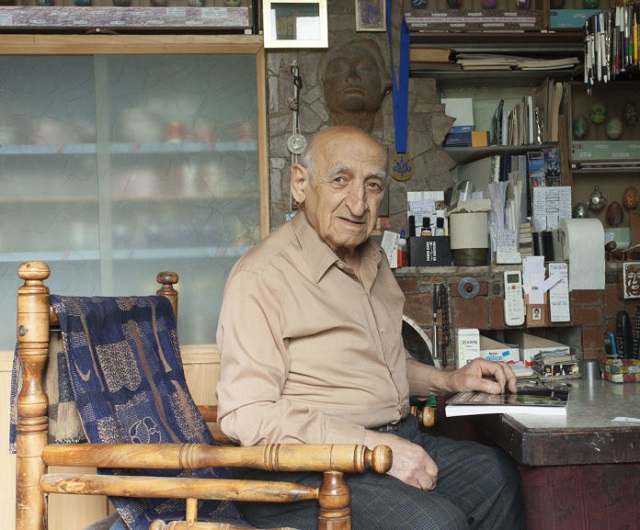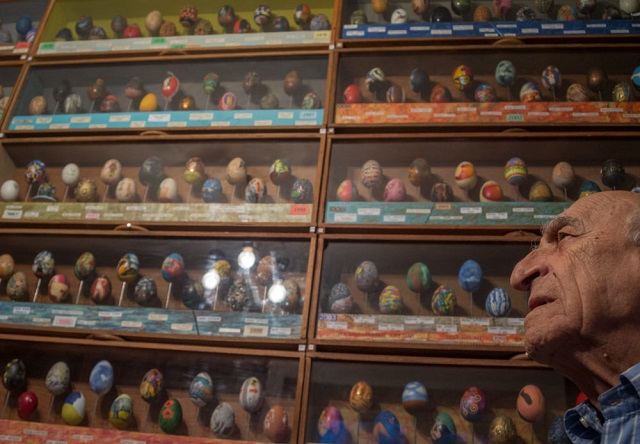The Armenian Mirror-Spectator. Musician, pedagogue, writer, art collector Yakov Zargaryan began his memoir, My Minas, with the following words: “I was lucky…” – referring his close friendship with eminent artist Minas Avetisyan.
Writing this article in his memory, I repeat his words in the plural: “We were lucky…” My family was lucky, moving in 1975 to the apartment at Estonakan 7 in Yerevan, where Yakov Zargaryan was our upstairs neighbor for 45 years.
Had he lived, he would have turned 95 in December. Who knows, in our troublesome times, the constrained immobility might have played a role in causing him to die. He used to say half-jokingly, half-seriously that he is going to live 120 years.
He was one of the most interesting personalities of Yerevan; people loved him and always sought after him. He was known in the world of music and painting, the media, the early inhabitants of our Ajapnyak district, and a number of Diaspora Armenian musicians who were educated in Yerevan, as Zargaryan had been the dean of the foreign students’ department of the conservatory for 16 years. Many knew him also in Russia: it is no accident that two years ago, Russian TV presenter Maxim Galkin hosted Zargaryan in his “The Oldest One” program.
His tiny two-room apartment was one of the showplaces of Yerevan. It was more than a gallery or a museum. I have entered it so many times and yet each time I found something new. (The same thing, by the way, happens every time when I enter the “house” of another multi-talented creative Armenian, Sergey Paradjanov). There, the ingenious and creative homeowner cleverly used every inch to open the door to surprises in almost every corner of the apartment. Before entering the apartment, the owner’s creativity can already be felt from the wooden sign on the door. The colorful “curtain” hanging in front of the door was made by the host from used ordinary and felt-tip pens. The exhibition of works of art starts from the walls of the corridor. The piano in the living room has lived its century as a musical instrument and now serves as a desk and secretaire. The collection, perched on every corner of the house, amazes with its variety, from the pottery of ancient times and the statue of Buddha to the works of the best representatives of modern painting and sculpture. But Yakov Zargaryan is best known for his collection of painted wooden, clay, glass and metal eggs (placed on shelves with special glass shutters, on wheels), which was “launched” by the patriarch of Armenian painting, Martiros Saryan, and the geography of artists from year to year covered the whole world.
The friendship between the Zargaryans and our family began one evening in the cold winter of 1992 without electricity, when Yakov Sergeyevich, or as I have called him all my life, dyadya (uncle in Russian) Yasha, came to our flat, saying that he wants to read his newly written article for us. We knew that our fourth floor neighbor was a pianist by profession, a professor at Yerevan State Conservatory, a distinguished pedagogue in Armenia, but we did not know that he was also writing. In the past, we slightly knew each other, but from that moment, when we invited him to sit by the oil stove, our relationship, friendship and cooperation began. Our long evenings in the darkness began to be marked by the long conversations of our artist and teacher neighbor, who had a remarkable way of life. And he had an inexhaustible energy to talk, a brilliant memory, a skill to present everything in detail. He spoke about everything. Being born in Yerevan, he vividly represented the city during his school years, the 1930s, when he was studying at the Spendiaryan Music School. He recounted his life in Russia, the years of World War II, and especially fondly remembered his student life (he graduated from prestigious Gorky Conservatory). He spoke proudly of his students at the Tchaikovsky Music School in Yerevan (one of them, Marine Abrahamyan, a laureate of international competitions, later told us how strict a teacher Yakov Sergeyich had been). He recalled his performances as pianist (he performed as a soloist in various cities of the Soviet Union and Italy). His expression and voice changed as he began to speak about his grandchildren (two at that time).
However, his greatest passion was reserved for Armenian painting, especially the constellation of the 1960s, with many of whom he was close friends: Saryan, Kochar, Galents, Bazhbeuk-Melikyan, Jotto, Karalov, Podpomogov, Elibekyans, Rudolf Khachatryan and especially Minas.
Yakov Zargaryan played a key role in popularizing of Minas Avetisyan’s work: Minas affectionately called him Hakob (Yakov is the Russian version of that name). In 1969 Minas wrote in the catalog of his exhibition to his friend: “For Hakob, to my dear, dear friend, who has done so much for my success.” Minas even created some portraits of him, also painted the door glass of Zargaryan’s apartment and the organic glass on the walls of the bathroom. Unfortunately, the difficult times pushed Zargaryan to sell these and other expensive samples of his collection.
The years of the Artsakh liberation war, full of trials and tribulations, made Yakov Zargaryan write down what he had in mind, both his professional interests and personal memoirs. In the mid-1990s, he published On the Pianist’s Way of Sitting, a methodological booklet and a volume of memoirs about Minas Avetistyan (both are in Armenian and Russian). These were followed by several volumes of essays, publicist articles and memoirs, which will always be useful for those interested in Armenian music and fine arts.
We were friends although our age difference was almost 50 years. He encouraged my writing, and from the Russian-language press he always clipped all the articles I might need one day. Many times I took to his house friends and acquaintances from various countries, for whom our country was also embodied in the image of that small, bald, steady collector with a big Armenian nose. During my travels abroad, he often gave me a wooden egg, and I always met an artist who gladly agreed to decorate it. When in 2013 Yakov Zargaryan’s photo book was printed presenting his collection of painted eggs, at that time the collection included 665 works by 585 artists from 43 countries. He continued to collect until one day he decided to stop because there was simply no room in his apartment. “The collector is the most insatiable person,” Yakov Sergeyich once said. “He has a hundred items, he wants to have hundred and one, he has 20,000, he wants to have 20,001. It is a disease. I am very happy that I am ‘suffering’ from that disease”…
He was an archivist, preserving every more or less valuable artifact. He was constantly coming up with new ideas. For example, he turned a notebook into a collection of autographs from famous acquaintances, asking them to write their wishes in the name of his eldest grandson. He felt sorry for those who did not read books, listening to rabiz music, watching TV soap operas. He followed the events in Armenia in detail and was always optimistic about its future.
A true inhabitant of Yerevan, always positive and lively, dynamic and creative, tireless collector, brilliant writer, great lover of beauty, full of cheerfulness, witty, warm and talkative Yakov Zargaryan dreamed that one day a new museum of personal collections would open in his beloved Yerevan, where his collection and first of all, his painted eggs, would find its final destination… Let it be!
.When Yakov Zargaryan had just moved to his apartment in the Ajapnyak district, he had planted a few poplar trees in the yard with his neighbor, near his garage. All the seedlings have taken root, have become trees. However, the life of the poplar is short, so over the years they have fallen one by one.
There was one left, which fell to the ground on May 22, 2020, the day Yakov Zargaryan passed away.
Artsvi Bakhchinyan
Special to the Mirror-Spectator
Main caption: Yakov Zargaryan (Photographed in Yerevan, Armenia by Georgs Avetisjans (Riga), 2018.)


























































